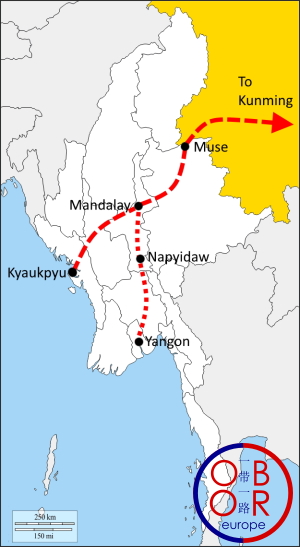by Dr. Sebastien Goulard

In early 2021, State Councilor and Minister of Foreign Affairs Wang Yi embarked on a mini tour of Southeast Asia and visited Myanmar, Indonesia, Brunei and Philippines.
In Myanmar, Wang Yi met with President U Win Myint, Commander-in-Chief of Defense Services Min Aung Hlaing and State Councilor Aug San Suu Kyi. Together, Chinese and Myanmarese leaders discussed about the development of the China Myanmar Economic Corridor and “Paukphaw” (fraternal) friendship that ties the two countries.
China Myanmar “Paukphaw” friendship
China and Myanmar enjoy excellent bilateral relations; Myanmar was among the first non-communist countries to recognize People Republic of China in 1949. Since then, Myanmar and China have always adopted good-neighbourhood policies. When Myanmar conducted political reforms in 2011, China showed support to its neighbour, and chose to continue to invest in Myanmar.
Last year, in 2020, President Xi Jinping visited Myanmar and was then introduced the principle of the “China-Myanmar community with a shared future”. Myanmar, a developing country that is opening to the world can learn from the Chinese experience. According to the Chinese President, the China-Myanmar community with a shared future consists in a rapid alignment of the development strategy of both countries. This will be achieved through more cooperation and coordination. China and Myanmar agreed to advance together with the adoption of a five-year cooperation plan. They have also adopted some inter-governmental mechanisms such as the China-Myanmar Joint Committee on Economic, Trade and Technical Cooperation and China-Myanmar Agricultural Cooperation Committee. A stronger coordination between China and Myanmar will surely accelerate the many projects that are under development in Myanmar.
The China Myanmar Economic Corridor
When President Xi Jinping launched the Belt and Road Initiative (BRI) in 2013, Myanmar enthusiastically joined the project, and the China Myanmar Economic Corridor (CMEC) became a major segment of the BRI. Before the BRI was launched, Myanmar already hosted several Chinese financed infrastructure project, but the CMEC has given an incredible boost to Chinese investment in the country.
For China, the CMEC offers important benefits. First, the CMEC, thanks to the numerous infrastructure projects will make its Southwest neighbour more stable and prosperous. With the CMEC, the province of Yunnan is given a more central role in Southeast Asia ; Kunming, the provincial capital is better connected to Southeast Asian countries. With the new BRI infrastructures, China will have a direct access to the Indian ocean. One gas pipeline and one oil pipeline have already been built between Myanmar’s coastline and Kunming.
Some delays and slow downs
Several BRI in Myanmar had faced some delays or have been postponed, but this does not mean that the country is not interested anymore in the initiative.
First, as mentioned earlier, Myanmar is undergoing some major economic and political reforms, and per consequence its stability remains fragile. Myanmar has to carefully scrutinize the impacts of BRI projects. The country, as it becomes more inclusive and democratic, has to pay more attention to local demands, that is why the Myitsone dam construction (a BRI project) has been temporarily suspended, due to local concerns about environmental consequences.
Myanmar is made of different states and regions, and in the past, had to cope with some separatist movements. As a result, Naypyidaw needs to be very careful with selecting infrastructure projects in order not to favour one region over others.
Furthermore, Myanmar has limited financing capacities (in 2020, Myanmar GDP nominal per capita was the lowest among ASEN countries), and so Naypyidaw can only select a few projects to finance.
Myanmar continues to open up to the world and wants to attract investors not only from China but also from other countries; that is why for example, the government chose to propose new tenders for the construction of Yangon New City, to attract companies from China and other countries.
Because of the above elements, some BRI projects in Myanmar have been delayed, but Naypyidaw is well aware of the advantages offered by the CMEC.
Current CMEC projects in Myanmar

Current BRI projects in Myanmar do not only include pipelines, but also Special Economic Zones (SEZs), ports, highways and railways.
On the Indian ocean, China and Myanmar have agreed to develop Kyaukphyu deep sea port and build a SEZ in this city. In Shan state, a China-Myanmar Border Economic Cooperation Zone is to open to Myanmarese, Chinese and foreign companies to bring development to this area.
Another project is the development of the New Yangon city that is to host new industries and foreign companies next to the former capital city.
One day before Wang Yi’s arrival to Myanmar, Beijing and Naypyidaw signed a memorandum of understanding to conduct feasibility study on the construction of the Mandalay-Kyaukphyu railway. In 2018, China and Myanmar already signed a feasibility study agreement on a possible railway connecting Mandalay with Muse on the Chinese border. When this railway construction is achieved, it will become a major axis for development in Myanmar, it will also help Chinese companies to bypass the congested strait of Malacca and shorten freight routes from oil-rich Middle East to China. For Myanmar, it is also an opportunity to make the future port of Kyaukphyu a major hub connecting Southeast Asia to the world.
In Myanmar, the BRI is closely tied with the national development strategy. When the construction of the planned railways and ports is effective, Myanmar will be able to attract more foreign companies (and not only Chinese ones). Like other developing countries, it can be hard for companies to have access to all regions because of the lack of infrastructure. Thanks to the BRI, this issue will be solved.
In spite of delays, the CMEC has become a core component of Myanmar’s national strategy.
Updates
On February 1, 2021, Myanmar’s staged a coup. Members of the civilian government were detained. This political change may affects the future of the CMEC and further delay some projects.
It may become more difficult to internationalize BRI projects in Myanmar. Chinese and international private companies may turn away from Myanmar due to political instability.
Share the post "China’s BRI in some ASEAN countries (1/4): the CMEC"
